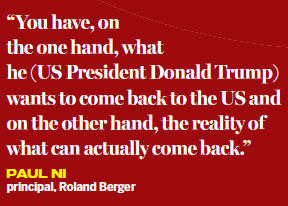Gearing up

Peter Williamson, professor of international management at Cambridge University's Judge Business School, says China is aiming to build an advanced high-end manufacturing sector which will be a core platform for the overall economy.
"It knows full well it can't build a high-income economy based on low-cost, labor-intensive manufacturing," he says
"It needs to build a more high-value industrial base, some of which it will be able to do itself, but some of it will rely on investment by foreign companies."
Williamson, a leading expert on Chinese innovation, believes China will have little difficulty attracting such investment.
"One of the advantages of the Chinese market is that it is the fastest growing, and in many cases the biggest, market in the world. If you take a company like Apple, almost a quarter of its profits and almost all the growth in its volume came from China."
Eric Thun, the Peter Moores associate professor in Chinese Business Studies at Oxford University's Said Business School, says that despite progress there are still challenges for China in upgrading its industry.
He cites the semi conductor industry, which receives large government subsidies but is still heavily reliant on imported chips - in particular from the US - for its high-end gadgets.
"There are still limitations as to what Chinese semiconductor companies can do," says Thun.
The American academic, who is an authority on the China automotive sector, says there have been challenges in the past in opening up these new sectors for investment.
"Sometimes it has worked and sometimes it hasn't. There have been these concerns in the international business community over the past couple of years about uncertainty," he says.
"There is frustration that the government wants to loosen things up for investment in some areas but makes it difficult for everyone else in others."
Whether the new US administration succeeds in persuading more of its native companies to base their operations back in their homeland remains to be seen.
There is, however, already an established trend for companies moving some of their activities back.
According to research by the non-profit organization Reshoring Initiative, some 249,000 jobs were moved back in the five years up to the end of 2015. This was more than the 220,000 that left between 2000 to 2003, seen as the peak period for offshoring globally.
He Weiwen, vice-president and senior fellow of the Center for China and Globalization, China's leading independent think tank, believes there is a limit on what can be moved back.
He points to US Department of Commerce statistics, which show that the value added per employee for US multinational overseas operations is 29 percent higher than that within the US.
"The only way to bridge that would be for Trump to cut the corporation tax rate from 35 to 20 percent and then impose a 10 percent tariff on goods of these companies coming back into the US. That would still not account for the higher medicare and legal costs involved in employing people in the US," he says.
"All this, however, would be a major violation of World Trade Organization rules."
















